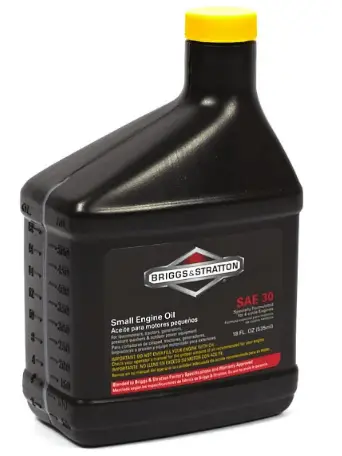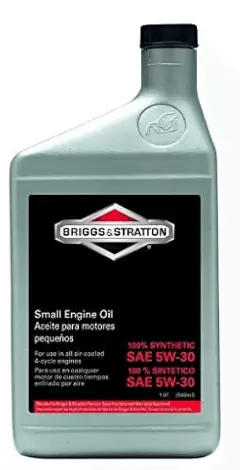One of the most critical maintenance tasks is regularly changing the engine oil. This process keeps the engine lubricated, reduces wear, and helps it run smoothly.
In this guide, we’ll walk you through the process of changing the oil on your Briggs and Stratton push mower, including the tools you’ll need, safety precautions, and tips for success.
Changing Oil on Briggs and Stratton Push Mower
Tools and Materials Needed
Before starting, gather the following items to ensure a smooth oil change process:
- SAE 30 oil (check recommended oil below)
- Oil filter wrench (if your mower has an oil filter)
- Oil drain pan or container
- Funnel
- Wrench or socket set (to remove the drain plug, if applicable)
- Shop rags or paper towels
- Gloves (to keep your hands clean and protected)
- Safety glasses (optional but recommended)
- Replacement oil filter (if your model includes one)
Step 1: Prepare the Mower
Safety and preparation are key to a successful oil change. Start by ensuring the mower is on a flat, level surface to prevent spills and ensure accurate oil measurements. Disconnect the spark plug wire to prevent accidental starts, which could be dangerous during maintenance.
Run the engine for a few minutes to warm up the oil. Warm oil flows more easily, making it simpler to drain completely. After warming up, turn off the engine and let it cool slightly to avoid burns.
Step 2: Drain the Old Oil
Locate the oil drain plug or dipstick tube, depending on your mower’s design. Most Briggs and Stratton push mowers have a dipstick tube for oil drainage, but some models include a drain plug underneath the engine.
- If your mower has a drain plug, place the oil drain pan directly beneath the plug. Use a wrench or socket to loosen and remove the plug, allowing the oil to flow into the pan. Tilt the mower slightly, if needed, to ensure all the oil drains out. Be patient, as this may take a few minutes.
- If draining through the dipstick tube: Remove the dipstick and tilt the mower toward the oil fill tube, allowing the oil to pour into the drain pan. Some models allow you to use a siphon pump for easier extraction.
Ensure the oil drains completely. While waiting, inspect the drained oil for metal shavings or unusual debris, which could indicate engine issues.
Step 3: Replace the Oil Filter (If Applicable)
Some Briggs and Stratton push mowers have an oil filter, particularly larger or more advanced models. If yours does, use an oil filter wrench to remove the old filter.
Before installing the new filter, lightly coat the rubber gasket with fresh oil to ensure a tight seal. Hand-tighten the new filter into place, being careful not to overtighten, which could damage the threads.
Related Briggs and Stratton Blowing Oil Out Exhaust(Causes and Solutions)
Step 4: Add New Oil
Once the old oil has drained and the filter (if applicable) is replaced, return the mower to a level position. If you removed a drain plug, reinstall it securely, ensuring no leaks.
Locate the oil fill tube (usually where the dipstick is inserted). Using a funnel, slowly pour in the recommended oil type (typically SAE 30 for most Briggs and Stratton mowers, but check your manual). Most push mowers require 15–20 ounces (0.45–0.6 liters) of oil, but refer to your owner’s manual for the exact capacity.
Check the oil level frequently using the dipstick, ensuring it reaches the “full” mark but does not exceed it. Overfilling can cause engine damage or leaks.
Step 5: Clean Up and Dispose of Old Oil
Wipe down any spills or drips on the mower with a shop rag. Securely replace the dipstick or oil fill cap. Reconnect the spark plug wire.
Dispose of the used oil responsibly.
Pour it into a sealed container and take it to a local recycling center or auto shop that accepts used motor oil. Never pour oil down a drain or into the ground, as this can harm the environment.
Related Briggs & Stratton Valve Clearance Chart(For All Models)
Step 6: Test the Mower
Start the mower and let it run for a minute to circulate the new oil. Check for leaks around the drain plug or oil filter. If everything looks good, your oil change is complete.
Recommended Oil for Briggs and Stratton Push Mower
1. Briggs & Stratton 100005 SAE 30W Engine Oil (18 oz bottle, pack variants)

A conventional straight‑30W oil approved by Briggs & Stratton for small engines such as push mowers, generators, and lawn equipment. Available individually or in multi‑packs (e.g., pack of 6).
Key Features:
- Viscosity: SAE 30W – optimal for warm ambient temps (~40‑100°F) and commonly used in 4‑cycle small engines.
- OEM replacement part #100005 – backed by Briggs & Stratton for warranty compliance.
- Suitable for multiple applications: lawn mowers, generators, small engines of various brands
2. Briggs & Stratton 100074 Full Synthetic SAE 5W‑30 Engine Oil (1‑Qt bottles)

A full‑synthetic oil in SAE 5W‑30 grade, designed for enhanced performance across a wider temperature range, ideal for colder conditions or extended engine protection
Key Features:
- Viscosity: SAE 5W‑30 – flows better at lower temperatures, easier starting, improved protection in colder climates.
- 100% Genuine Briggs & Stratton OEM oil (part #100074), formulated for air‑cooled 4‑cycle engines such as lawn mowers, snow blowers, and Troy‑Bilt equipment.
Related Briggs and Stratton Leaking Oil From Bottom(5 Causes and Solutions)
Tips for Success
- Use quality oil: Stick to high-quality oils recommended by Briggs and Stratton to ensure optimal engine performance.
- Keep a maintenance log: Track oil changes and other maintenance tasks to stay on schedule.
- Inspect regularly: While changing the oil, check the air filter, spark plug, and blade condition to keep your mower in top shape.
- Work in a well-ventilated area: Avoid inhaling fumes from oil or gasoline.
Related Briggs and Stratton Engine Bogs Down Under Load(Solved)
Common Mistakes to Avoid
- Overfilling or underfilling: Too much or too little oil can harm the engine. Always check the dipstick.
- Using the wrong oil: Incorrect oil viscosity can reduce engine efficiency or cause damage.
- Skipping regular changes: Waiting too long between oil changes can lead to sludge buildup and engine wear.
- Improper disposal: Always recycle used oil properly to avoid environmental harm.
Final words
Changing the oil on your Briggs and Stratton push mower is a straightforward task that can significantly extend the life of your equipment. By following these steps and taking the time to perform regular maintenance, you’ll keep your mower running smoothly season after season.
With just a little effort, about 20–30 minutes, you can ensure your mower is ready to tackle your lawn with ease. So, grab your tools, follow this guide, and enjoy the satisfaction of a well-maintained machine!




